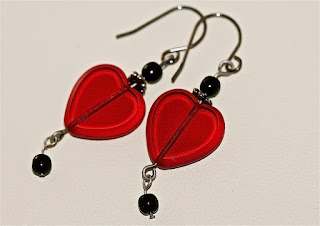For my project I wanted a vintage style design, so I used black gunmetal chain, jet black Czech glass beads, and a Victorian style antiqued silver drop as my eyeglass loop.
Materials:
- Chain - I used black gunmetal rollo style with 3mm links
- Czech glass beads in jet black - two 10mm and four 6mm size for this design
- Gunmetal wire for wire wrapping - I used 20 gauge
- Antiqued silver Victorian style drop
- Two antiqued silver jump rings
Tools:
- Round nose and needle nose pliers
- Wire cutters
- Emory board or fine sandpaper
Steps:
1. I selected a Victorian style antiqued silver drop for my eyeglass loop, but it was longer than what I wanted for my design. Remember it is always okay to customize a component to suit your tastes or the needs of a particular project. To modify this piece, snip off the top using your wire cutters. Use a nail file or sandpaper to smooth any rough edges after cutting. This piece is sold by Vintage Jewelry Supplies - one of my favorite on-line jewelry supply sources.
 |
| Original and Modified Component |
2. Now decide how long you want your finished eyeglass chain - I decided on a 29 inch length which will slip easily over my head so no clasp is needed. Then cut your sections of chain. I used six 2-inch pieces of chain and one longer 12-inch piece for the middle part which will drape around the back of the neckline.
3. Cut six pieces of wire into 2 1/2 inch lengths. Now you are ready to wire-wrap your beaded links. I like to wire-wrap my links directly to the chain for added security - but you can also use jump rings to attach them. To bead the links directly into the chain, make a simple loop, then before wire-wrapping it, slide one end of a piece of chain onto the loop. Then wire-wrap the loop, add your bead, then repeat for the other end, making sure you attach the next piece of chain to the loop before wire-wrapping.
 |
4. Continue making wire-wrapped links and connecting all pieces of chain. For this pattern, you will end up with a long piece of beaded chain ready to connect to your eyeglass loop.
Here is the finished design ready to wear:
This project can be modified and adapted into many different designs and patterns - just use your imagination!
Be sure to visit my Etsy shop to see more beaded eyeglass chains:

























